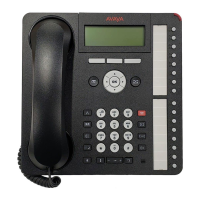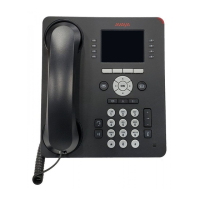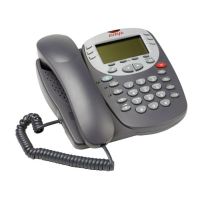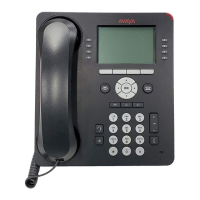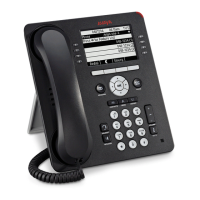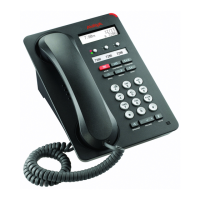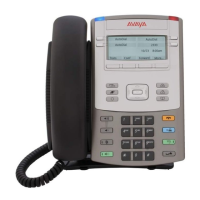Do you have a question about the Avaya IP Office 1408 and is the answer not in the manual?
Provides crucial safety guidelines for using Avaya phones, including handling small objects and electrical precautions.
Details the main features and physical layout of the 1408 IP Phone model.
Details the main features and physical layout of the 1416 IP Phone model.
Explains the function of each key on the Avaya phone, including soft keys, navigation, and feature buttons.
Describes the primary menus accessible from the phone, including Appearance, Status, and Features menus.
Explains how to compose and edit numbers on the phone display before dialing using En-Bloc mode.
Details the various soft key options that appear during and after a call, such as Answer, Hold, and Drop.
Guides users on how to initiate calls by accessing and selecting contacts from the phone's directory.
Describes how to redial previously made calls using either list mode or one-number mode.
Explains how to select the option to withhold your phone number on external calls, if supported.
Provides steps to redirect an incoming call directly to a voicemail box.
Details how to enable the auto-answer feature for incoming internal calls.
Explains how to answer calls ringing on other extensions or hunt groups within the system.
Instructions for redialing the most recent outgoing call using the phone's 'One' mode setting.
Steps for redialing calls from the list of recent outgoing calls using 'List' mode.
Guides users on how to choose between 'List' mode and 'One' mode for redialing.
Details the process of placing a call on hold, occupying an appearance button, and hearing hold music.
Explains the process of parking calls, making them accessible to other users via short codes.
Provides step-by-step instructions for parking calls using the phone's menu system.
Guides users on how to transfer a current call to another user's voicemail mailbox.
Explains various scenarios for transferring calls that are currently on hold to a new destination.
Details the procedure for entering an account code when required by the system for specific calls.
Provides instructions on how to manually enter an account code during or before making a call.
Step-by-step guide on initiating a conference call with another party.
Instructions on how to add additional callers to an existing conference call.
Explains how to view conference details, drop, or mute individual participants.
Covers answering, ending, and switching calls using the phone's headset.
Details how to use the phone's built-in speaker and microphone for handsfree calls.
Explains how to access and view details of contacts stored in the phone's directory.
Guides users on initiating calls by selecting entries from the phone's directory.
Provides instructions for adding new personal contacts to the phone's directory.
Explains how to access, view, and use the call log for making calls or viewing details.
Details how to view specific information about individual call log entries.
Provides instructions for deleting individual call log entries or clearing the entire log.
Guides users on how to access and listen to voicemail messages via the phone's interface.
Explains the process of recording and sending voice messages to other users' mailboxes.
Details how to record and manage a personalized greeting for your voicemail box.
Provides instructions for logging into the phone system to access user settings and calls.
Explains how to manually lock the phone for security and unlock it using a login code.
Details how to configure the phone to automatically lock after a period of inactivity.
Explains how to set up 'Follow Me' to redirect calls to another extension or work location.
Covers unconditional, busy, and no-answer forwarding settings for calls.
Details how to enable and manage the Do Not Disturb feature, including exception numbers.
Explains internal and mobile twinning, allowing calls to ring on multiple phones.
Guides users on how to enable or disable their membership in hunt groups.
Explains how to change group service modes (In Service, Night Service, Out of Service) and fallback destinations.
Provides instructions on how to assign functions to programmable feature keys on the phone.
Lists various features that can be assigned to programmable buttons, such as speed dial and call pickup.
Details how to set up and manage mobile twinning, allowing calls to ring on a mobile device.
Explains how to choose between 'List' and 'One' modes for redialing calls.
Guides users on how to enable or disable En-Bloc dialing for composing numbers before dialing.
Details how to configure the phone to automatically lock after a period of inactivity.
Covers adjustments for display brightness, contrast, call timers, and language.
Explains how to adjust button clicks, error tones, ringer, handset, headset, and speaker volumes.
Provides steps to switch Do Not Disturb on or off using the Status menu.
Guides users on how to manage 'Follow Me To' call redirection settings via the Status menu.
Details how to clear or change 'Forward On No Answer' settings through the Status menu.
Explains how to clear or change 'Forward Unconditional' settings using the Status menu.
Provides instructions to switch mobile twinning mode on or off via the Status menu.
Explains how to view system alarms and potential causes indicated by status letters.
Details how short codes enable and disable various phone features via dialing.
Guides users on how to check the system software version for troubleshooting purposes.
Explains how to view time server settings, UTC, and local time on the phone system.
Details the process for shutting down the telephone system for a specified duration.
Covers checking memory card status and performing actions like backup and restore.
Explains system alarms, their causes, and how they are indicated on the phone display.
Explains how to access the Features menu to change user settings and assign functions to buttons.
Details how to use the Self-Administer sub-menu to manage button assignments and features.
Guides users through accessing voicemail messages and settings via the Visual Voice menu.
Explains how to access and modify feature statuses like Do Not Disturb and Call Forwarding.
Details how to configure phone-specific settings and view software details using the A-Menu.
Explains how system administrators control access to various phone menu options.
Defines 'Abbreviated Ring' as a single non-repeated ring, typically used for secondary alerts.
Defines Appearance Buttons as used to represent and manage calls on the phone system.
Defines 'Do Not Disturb' as a feature that redirects callers to voicemail or busy tone.
Provides a record of document revisions, including dates, issue numbers, and changes made.
